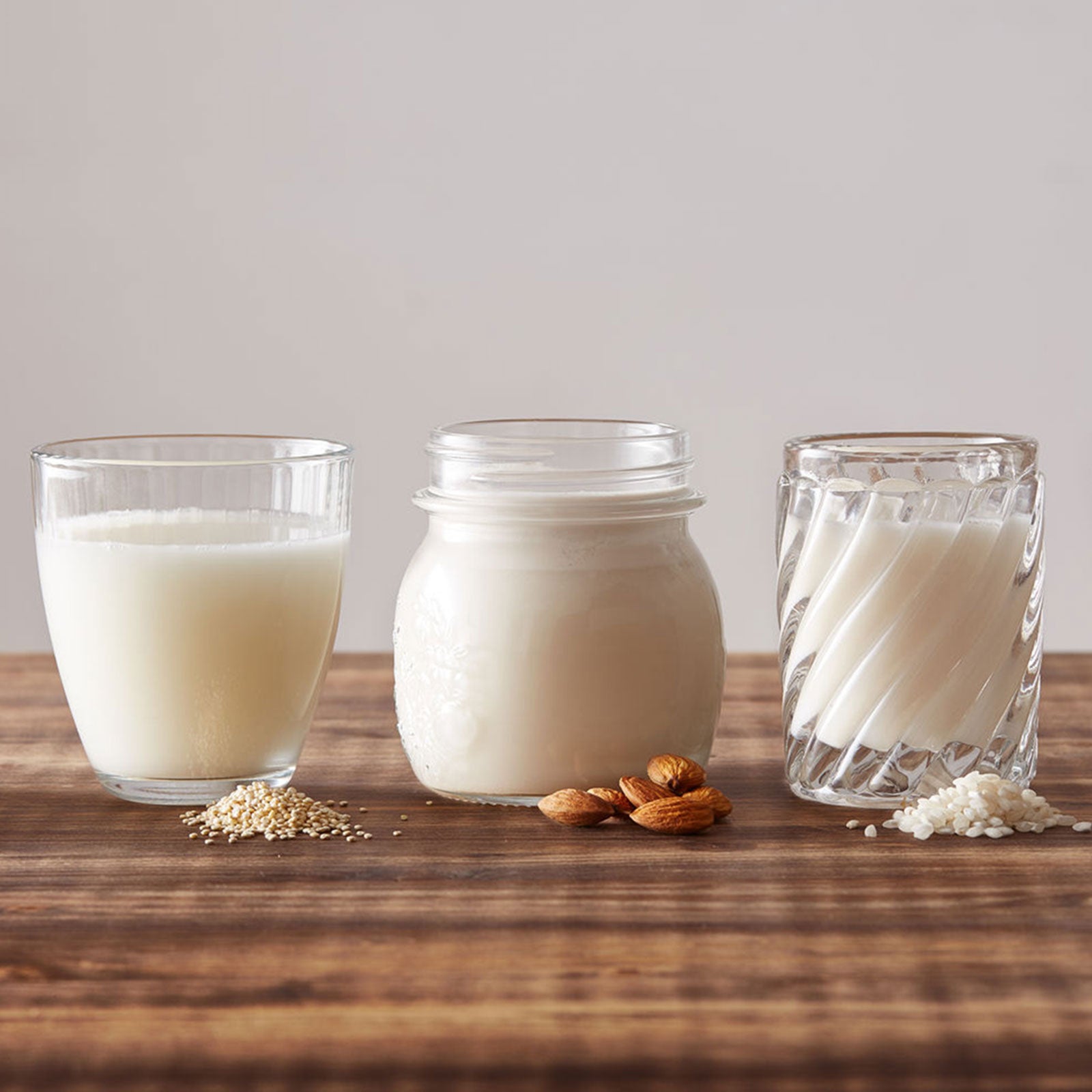If your local coffee shopÔÇÖs menu has grown more confusing in the past few years, youÔÇÖre not alone. Nondairy milk alternatives have expanded to include a wide variety of options (pea milk, anyone?), all of which maintain a healthy reputation. It can be tricky to keep them straight, much less sort out which ones are actually good for youÔÇöand which are worth the price. As with most nutrition questions, those answers vary from person to person.╠řÔÇťDonÔÇÖt assume that all plant-based milks are all created equal,ÔÇŁ says Lori Nedescu, a registered dietitian nutritionist and professional bike racer. ÔÇťIf you line these products up, theyÔÇÖre all nutritionally different from cowÔÇÖs milk. Think of these alternatives as the liquid form of their original food.ÔÇŁ
Whether youÔÇÖre eating around dietary restrictions or simply╠řlooking for a new flavor profile, more protein, or an eco-friendly option, hereÔÇÖs what you need to know about the many products masquerading as milk.
CowÔÇÖs Milk
Good old cowÔÇÖs milk is relatively cheap (around $1.50 per half-gallon), easy to find, and seriously good for you. ÔÇťIf we were going to be stranded on an island, milk would be an amazing food to have,ÔÇŁ Nedescu says. ÔÇťIt has fat, protein, carbohydrates, calcium, and B vitamins. It covers a lot of our nutrition bases.ÔÇŁ╠řA cup of whole milk nets just under 150 calories, with 12 grams of carbohydrates and eight╠řgrams of protein, so it naturally acts as an ideal recovery beverage postworkout. It also contains around 25 percent of your recommended calcium and vitamin D intake, plus 10 percent of recommended potassium.╠ř
The ╠řin dairy today has hurt milkÔÇÖs reputation as a healthy part of a balanced diet. All milk contains small levels of hormones like various estrogens, but╠ř like Stonyfield╠řwill help you steer clear of GMOs like rBST. Just remember that organic milk increases╠řthe price to around $3 per half-gallon. ÔÇťI think itÔÇÖs worth springing for the organic,ÔÇŁ says Nedescu.╠ř
However, across the board, cowÔÇÖs milk has the most detrimental╠řenvironmental impact: according to an a single╠řglass of cowÔÇÖs milk uses more land and three times the greenhouse-gas emissions of any of the plant-based alternatives.
Lactose-Free Milk
According to the , approximately 65 percent of the human population (and 90 percent of adults of East Asian ancestry) have a reduced ability to digest lactose, a complex sugar found in milk, after infancy. Lactose-free milk╠řhas a╠řnutrition profile similar╠řto regular milk╠řand offers a nice compromise for those who canÔÇÖt digest the standard stuff, says Matt Fitzgerald, a certified sports nutritionist and the bestselling author of and . Lactose-free milk isnÔÇÖt made by removing lactose. Instead, manufacturers add the enzyme lactase, which breaks lactose down into easily digested sugars.
While thereÔÇÖs no downside to lactose-free milk other than a slight increase in price, it can be harder to find. It also tastes slightly sweeter than regular milk, since our tongue╠řrecognizes simple sugars as sweeter than complex ones.╠ř╠ř
GoatÔÇÖs Milk
GoatÔÇÖs milk contains less lactose than cowÔÇÖs milk and is more nutritionally dense, with 168 calories per cup and around ten╠řgrams each of fat, protein, and carbohydrates, as well as vitamin D, calcium,╠řand potassium.╠řÔÇťIt has great body and flavor,ÔÇŁ says Nedescu.╠řThe creamier texture also makes it a favorite for lattes and cooking.╠ř
But it isnÔÇÖt easy to find in your average grocery store. Whole Foods stocks several brands, and small╠řspecialty stores might have╠řa few╠řoptions available. ItÔÇÖs also the priciest on the list, at around $10 for a half-gallon. Unlike cowÔÇÖs milk, the flavor of goatÔÇÖs milk can change depending on goat breed and processing, so you may find that some brands taste sweet and mild, while╠řothers have a strong, more pungent flavor.
Rice Milk
Unsweetened rice milk is primarily╠řcarbohydrates, with 11 grams per one-cup serving, and while it doesnÔÇÖt contain any protein, the carb-heavy base makes it ideal for preworkout fueling. At 70 calories per cup, it sits╠řbetween cowÔÇÖs milk and almond milk on the caloric spectrum, and it contains 25 percent of your daily calcium requirement.
ÔÇťOften╠řrice milk contains brown-rice syrup in addition to just plain rice, and thatÔÇÖs sugar by another name,ÔÇŁ says Fitzgerald. ÔÇťI encourage people to look for milk alternatives that arenÔÇÖt sweetened, and rice milk is a big offender.ÔÇŁ Check the label for other common additives, like canola oil, tapioca starch, and xanthan gum, used to thicken the texture. At $6 for a half-gallon, itÔÇÖs slightly more expensive than almond milk.
Hemp Milk
This other recently trendy milk alternative╠řhas more fat and protein than almond or rice milk, with 4.7 grams of protein and 7.3 grams of fat (in the form of essential omega-3 and omega-6 fatty acids) per 83-calorie serving. Unlike many plant-based options, it contains complete proteins╠řwith the full range of amino acids, which makes it ideal for a postworkout recovery smoothie.
Like other alternatives, be wary of the ingredient list when purchasing hemp milk at your local natural grocery storeÔÇöoften╠řitÔÇÖs fortified with sugars, thickeners, and vitamins A, B12, and D to mimic cowÔÇÖs milk. A half-gallon will run around $8.
Almond Milk
Almond milk is great if youÔÇÖre looking for a traditional╠řmilk flavor and texture with fewer╠řcalories.╠řBut unsweetened, unfortified versions of almond milk are . A serving of unsweetened almond milk is around 40 calories, primarily from fat.
Almonds themselves have a high content of monounsaturated fatty acids that are considered helpful for╠řweight loss, and marketing for almond milk can give╠řthe impression that each bottle is╠řpacked with almonds. But (one of the largest milk-alternative brands)╠řin 2015 alleged that each bottle contained less than 2 percent almonds.╠řThe environmental impact is also worth noting: 80 percent of nuts used in almond milk are grown in drought-prone California, .
Almond milk is available in╠řa wide range of price points. You can buy shelf-stable boxes for under $4 per half-gallon, or╠řspend around $5 for a half-gallon of fresh, refrigerated versions from brands like Califia Farms, or make it at home by soaking almonds and running them through the food processor before straining them.
Soy Milk
╠řthat compared plant-based milk alternatives found soy to have the most balanced nutritional profile of the bunch.╠řSilkÔÇÖs versionÔÇöitÔÇÖs╠řone of the original soy-milk producersÔÇöhas 80 calories per cup, with four╠řgrams of fat, seven╠řgrams of protein,╠řand three╠řgrams of carbohydrates, making it similar in protein and fat to a glass of 2 percent╠řmilk.╠řSilk also fortifies its soy milk with vitamins A, D2,╠řand B12, and adds gellan gum to make it thicker.╠ř
Soy milk is the cheapest of the plant-based optionsÔÇöit costs anywhere from $1 to $3 for a half-gallonÔÇöand is the easiest to find in any grocery store, since itÔÇÖs been on the market the longest.╠řThe major downside is that soy milk doesnÔÇÖt respond well to heat, curdling at high temperatures. ThatÔÇÖs why almond milk has become a popular coffee-shop milk alternative.
Oat Milk
Oat milk has grown╠řin popularity in recent years, even╠řsneaking onto select Starbucks╠řmenus in the past month. ÔÇťItÔÇÖs very big in lattes now, thanks to its creamier texture,ÔÇŁ says Nedescu. ItÔÇÖs also closer to cowÔÇÖs milk in terms of caloric content: 120 calories per cup, packing 16 grams of carbs and five╠řgrams of fat into each serving.╠řÔÇťBefore a workout, an oat milk thatÔÇÖs a little higher in carbohydrates is a good choice,ÔÇŁ says Nedescu.
Since oat milk is often fortifiedÔÇöOatly, for instance, adds vitamins A, D, and B12, as well as calciumÔÇöif╠řyou make your own oat milk by soaking and straining oats, you wonÔÇÖt get any of the vitamins or minerals. Fitzgerald╠řnotes that while fortified products arenÔÇÖt necessarily bad for you, he prefers options with naturally occurring nutrients. Oat milk is╠řalso a bit pricier than soy or almond milk, at $5 per half-gallon, and it can be harder to find at budget grocery stores, though it is now available at Target.╠ř
Sponsor Content
Banana Milk
is a non-dairy milk made with real, whole bananas and fiber-rich oats. Featuring a naturally sweet and creamy consistency, Banana Wave is available in four flavors including Original, Chocolate, Strawberry, and Mango. Each is made with plant-based ingredients, with no artificial sweeteners, flavors, or coloring. Banana Wave is packed with vitamins A, B12, C, and D, as well as fiber and potassium. ItÔÇÖs also gluten-free, fat-free, low in calories, and Non-GMO Project verified. is available in 32-ounce╠řcartons ($3.99; all flavors) and a portable 8-ounce╠řsize ($1.49); (Original and Chocolate flavors only).
Coconut Milk
Coconut milk used to come exclusively in a can, and youÔÇÖd sooner╠řfind it in curry than a latte. But now╠řmore processed, drinkable forms of coconut milk are sold in cartons by the gallon, with a texture similar to almond milk. Both varieties are╠řhigher in fat and potassium and lower in protein than other milks, explains Nedescu. The caloric difference between a cup of canned coconut milk versus a cup of So Delicious coconut milk is noteworthy: a cup of canned milk has 445 calories with 48 grams of fat, while╠řSo Delicious has a mere 45 calories and 4.5 grams of fat. Both offer a full daily dose of vitamin B.╠ř
Most canned coconut milk costs╠řaround $2 for a 14-ounce can. Look for brands that only include coconut milk,╠řno fillers. A╠řhalf-gallon container from a brand like So Delicious╠řcosts $4.
Cashew Milk
Like almond milk, unsweetened versions of cashew milk are low on macronutrients. So if youÔÇÖre mainly╠řtrying to reduce overall daily caloric intake, swapping whole milk for a nut milk might be a place to start, but for an athlete looking to fuel performance, cashew milk comes up short. Compared to almond milk, cashew milk is slightly creamier, but a single-cup serving is a mere 25 calories, primarily from fat.╠ř
Like almond milk, itÔÇÖs possible to make your own at home by soaking and straining cashews. ItÔÇÖll save you some cash: a half-gallon of cashew milk will run around $3.50. Most major grocery stores, including Walmart and Target, stock at least one brand.
Pea Milk
Pea milk is derived from pea protein╠řand offers a similar amount of protein and fat as╠řregular whole milk (eight╠řand five╠řgrams, respectively)╠řbut no carbohydrates. ItÔÇÖs also high in calciumÔÇöcontaining almost twice the amount found in cowÔÇÖs milkÔÇöas well as potassium. Because of its high protein content, itÔÇÖs great postworkout, especially blended in a smoothie with some fruit for added carbs.
Most brands making pea milk boost it with additives like sunflower and algal oils, which offer a smooth texture and additional nutrients like omega-3 fatty acids. It typically costs around $6.50 for a half-gallon, making it one of the more expensive╠řoptions.
The Bottom Line
ÔÇťI donÔÇÖt think thereÔÇÖs a good, solid replacement for milk, if youÔÇÖre looking at it from a nutrient standpoint,ÔÇŁ Nedescu says. ÔÇťWhen you look at a plant-based milk, one falls short on protein, one falls short on fat, one falls short on calcium. There will be trade-offs, so I always recommend mixing up the types of milk youÔÇÖre usingÔÇöitÔÇÖs good to have a little of everything.ÔÇŁ
Fitzgerald╠řpoints out that╠řthey offer vastly different flavor profiles and cooking adaptations as well. ÔÇťIt honestly comes down to which one you prefer as far as taste goes,╠řor whatÔÇÖs the point of drinking it at all?ÔÇŁ he says.


